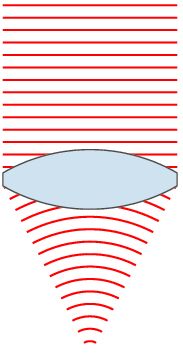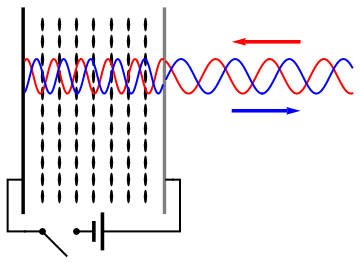|
Pyramid Wavefront Sensor
A pyramid wavefront sensor is a type of a wavefront sensor. It measures the optical aberrations of an optical wavefront. This wavefront sensor uses a pyramidal prism with a large apex angle to split the beam into multiple parts at the geometric focus of a lens. A four-faceted prism, with its tip centered at the peak of the point spread function, will generate four identical pupil images in the absence of optical aberrations. In the presence of optical aberrations, the intensity distribution among the pupils will change. The local wavefront gradients can be obtained by recording the distribution of intensity in the pupil images. The wavefront aberrations can be evaluated from the estimated wavefront gradients. It has potential applications in astronomy and ophthalmology. Modulation The prism is often modulated (mechanically moved in a circle/square) for averaging purposes and to make sure that the ray spends an equal fraction of the total time on every face of the pyramidal prism ... [...More Info...] [...Related Items...] OR: [Wikipedia] [Google] [Baidu] |
Wavefront Sensor
In physics, the wavefront of a time-varying ''wave field'' is the set (locus) of all points having the same '' phase''. The term is generally meaningful only for fields that, at each point, vary sinusoidally in time with a single temporal frequency (otherwise the phase is not well defined). Wavefronts usually move with time. For waves propagating in a unidimensional medium, the wavefronts are usually single points; they are curves in a two dimensional medium, and surfaces in a three-dimensional one. For a sinusoidal plane wave, the wavefronts are planes perpendicular to the direction of propagation, that move in that direction together with the wave. For a sinusoidal spherical wave, the wavefronts are spherical surfaces that expand with it. If the speed of propagation is different at different points of a wavefront, the shape and/or orientation of the wavefronts may change by refraction. In particular, lenses can change the shape of optical wavefronts from planar to sp ... [...More Info...] [...Related Items...] OR: [Wikipedia] [Google] [Baidu] |
Optical Aberration
In optics, aberration is a property of optical systems, such as lenses, that causes light to be spread out over some region of space rather than focused to a point. Aberrations cause the image formed by a lens to be blurred or distorted, with the nature of the distortion depending on the type of aberration. Aberration can be defined as a departure of the performance of an optical system from the predictions of paraxial optics. In an imaging system, it occurs when light from one point of an object does not converge into (or does not diverge from) a single point after transmission through the system. Aberrations occur because the simple paraxial theory is not a completely accurate model of the effect of an optical system on light, rather than due to flaws in the optical elements. An image-forming optical system with aberration will produce an image which is not sharp. Makers of optical instruments need to correct optical systems to compensate for aberration. Aberration can be anal ... [...More Info...] [...Related Items...] OR: [Wikipedia] [Google] [Baidu] |
Wavefront
In physics, the wavefront of a time-varying ''wave field'' is the set (locus) of all points having the same ''phase''. The term is generally meaningful only for fields that, at each point, vary sinusoidally in time with a single temporal frequency (otherwise the phase is not well defined). Wavefronts usually move with time. For waves propagating in a unidimensional medium, the wavefronts are usually single points; they are curves in a two dimensional medium, and surfaces in a three-dimensional one. For a sinusoidal plane wave, the wavefronts are planes perpendicular to the direction of propagation, that move in that direction together with the wave. For a sinusoidal spherical wave, the wavefronts are spherical surfaces that expand with it. If the speed of propagation is different at different points of a wavefront, the shape and/or orientation of the wavefronts may change by refraction. In particular, lenses can change the shape of optical wavefronts from planar to spher ... [...More Info...] [...Related Items...] OR: [Wikipedia] [Google] [Baidu] |
Prism (optics)
An optical prism is a transparent optics, optical element with flat, polished surfaces that are designed to refraction, refract light. At least one surface must be angled — elements with two parallel surfaces are ''not'' prisms. The most familiar type of optical prism is the triangular prism, which has a triangular base and rectangular sides. Not all optical prisms are prism (geometry), geometric prisms, and not all geometric prisms would count as an optical prism. Prisms can be made from any material that is transparent to the wavelengths for which they are designed. Typical materials include glass, acrylic glass, acrylic and fluorite#Optics, fluorite. A dispersive prism can be used to break white#White light, white light up into its constituent spectral colors (the colors of the rainbow) as described in the following section. Other types of prisms noted below can be used to reflection (physics), reflect light, or to split light into components with different polarization (w ... [...More Info...] [...Related Items...] OR: [Wikipedia] [Google] [Baidu] |
Apex (geometry)
In geometry, an apex (plural apices) is the vertex which is in some sense the "highest" of the figure to which it belongs. The term is typically used to refer to the vertex opposite from some " base". The word is derived from the Latin for 'summit, peak, tip, top, extreme end'. Isosceles triangles In an isosceles triangle In geometry, an isosceles triangle () is a triangle that has two sides of equal length. Sometimes it is specified as having ''exactly'' two sides of equal length, and sometimes as having ''at least'' two sides of equal length, the latter versio ..., the apex is the vertex where the two sides of equal length meet, opposite the unequal third side. Pyramids and cones In a Pyramid (geometry), pyramid or Cone (geometry), cone, the apex is the vertex at the "top" (opposite the base). In a pyramid, the vertex is the point that is part of all the lateral faces, or where all the lateral edges meet. References {{elementary-geometry-stub Parts of a triangle ... [...More Info...] [...Related Items...] OR: [Wikipedia] [Google] [Baidu] |
Focus (optics)
In geometrical optics, a focus, also called an image point, is a point where light rays originating from a point on the object converge. Although the focus is conceptually a point, physically the focus has a spatial extent, called the blur circle. This non-ideal focusing may be caused by aberrations of the imaging optics. In the absence of significant aberrations, the smallest possible blur circle is the Airy disc, which is caused by diffraction from the optical system's aperture. Aberrations tend to worsen as the aperture diameter increases, while the Airy circle is smallest for large apertures. An image, or image point or region, is in focus if light from object points is converged almost as much as possible in the image, and out of focus if light is not well converged. The border between these is sometimes defined using a "circle of confusion" criterion. A principal focus or focal point is a special focus: * For a lens, or a spherical or parabolic mirror, it is a point ... [...More Info...] [...Related Items...] OR: [Wikipedia] [Google] [Baidu] |
Lens (optics)
A lens is a transmissive optical device which focuses or disperses a light beam by means of refraction. A simple lens consists of a single piece of transparent material, while a compound lens consists of several simple lenses (''elements''), usually arranged along a common axis. Lenses are made from materials such as glass or plastic, and are ground and polished or molded to a desired shape. A lens can focus light to form an image, unlike a prism, which refracts light without focusing. Devices that similarly focus or disperse waves and radiation other than visible light are also called lenses, such as microwave lenses, electron lenses, acoustic lenses, or explosive lenses. Lenses are used in various imaging devices like telescopes, binoculars and cameras. They are also used as visual aids in glasses to correct defects of vision such as myopia and hypermetropia. History The word ''lens'' comes from '' lēns'', the Latin name of the lentil (a seed of a lentil plant), ... [...More Info...] [...Related Items...] OR: [Wikipedia] [Google] [Baidu] |
Astronomy
Astronomy () is a natural science that studies astronomical object, celestial objects and phenomena. It uses mathematics, physics, and chemistry in order to explain their origin and chronology of the Universe, evolution. Objects of interest include planets, natural satellite, moons, stars, nebulae, galaxy, galaxies, and comets. Relevant phenomena include supernova explosions, gamma ray bursts, quasars, blazars, pulsars, and cosmic microwave background radiation. More generally, astronomy studies everything that originates beyond atmosphere of Earth, Earth's atmosphere. Cosmology is a branch of astronomy that studies the universe as a whole. Astronomy is one of the oldest natural sciences. The early civilizations in recorded history made methodical observations of the night sky. These include the Babylonian astronomy, Babylonians, Greek astronomy, Greeks, Indian astronomy, Indians, Egyptian astronomy, Egyptians, Chinese astronomy, Chinese, Maya civilization, Maya, and many anc ... [...More Info...] [...Related Items...] OR: [Wikipedia] [Google] [Baidu] |
Ophthalmology
Ophthalmology ( ) is a surgical subspecialty within medicine that deals with the diagnosis and treatment of eye disorders. An ophthalmologist is a physician who undergoes subspecialty training in medical and surgical eye care. Following a medical degree, a doctor specialising in ophthalmology must pursue additional postgraduate residency training specific to that field. This may include a one-year integrated internship that involves more general medical training in other fields such as internal medicine or general surgery. Following residency, additional specialty training (or fellowship) may be sought in a particular aspect of eye pathology. Ophthalmologists prescribe medications to treat eye diseases, implement laser therapy, and perform surgery when needed. Ophthalmologists provide both primary and specialty eye care - medical and surgical. Most ophthalmologists participate in academic research on eye diseases at some point in their training and many include research as part ... [...More Info...] [...Related Items...] OR: [Wikipedia] [Google] [Baidu] |
Spatial Light Modulator
A spatial light modulator (SLM) is an object that imposes some form of spatially varying modulation on a beam of light. A simple example is an overhead projector transparency. Usually when the term SLM is used, it means that the transparency can be controlled by a computer. In the 1980s, large SLMs were placed on overhead projectors to project computer monitor contents to the screen. Since then, more modern projectors have been developed where the SLM is built inside the projector. These are commonly used in meetings of all kinds for presentations. Usually, a SLM modulates the intensity of the light beam. However, it is also possible to produce devices that modulate the phase of the beam or both the intensity and the phase simultaneously. SLMs are used extensively in holographic data storage setups to encode information into a laser beam similarly to way a transparency does for an overhead projector. They can also be used as part of a holographic display technology. SLMs have ... [...More Info...] [...Related Items...] OR: [Wikipedia] [Google] [Baidu] |
Brian Vohnsen
Brian Vohnsen is an Associate Professor of Physics at UCD in Dublin, Ireland specializing in optics. He is head of the Advanced Optical Imaging Group which he founded in 2008. He has received recognition for his ability to connect the field of biomedical optics and nano-optics. In 2021 he became a fellow of Optica for significant contributions to vision science, including photoreceptor optics and high resolution retinal imaging. Early life and education Brian Vohnsen, born in Aarhus Denmark studied Engineering at Aalborg University before transferring into the field of Optics. In 1994 he graduated with a Masters of Science in Optical Engineering and Laser Technology before going on to complete a PhD in Optical Physics at the same university in 1998. He went on to become an Assistant Professor at Aalborg University for 3 years after completing his PhD, before moving to Spain after being awarded a Marie-Curie Fellowship where he worked as a researcher in Universidad de Murcia ... [...More Info...] [...Related Items...] OR: [Wikipedia] [Google] [Baidu] |
Observational Astronomy
Observational astronomy is a division of astronomy that is concerned with recording data about the observable universe, in contrast with theoretical astronomy, which is mainly concerned with calculating the measurable implications of physical models. It is the practice and study of observation, observing celestial objects with the use of telescopes and other astronomical instruments. As a space science, science, the study of astronomy is somewhat hindered in that direct experiments with the properties of the distant universe are not possible. However, this is partly compensated by the fact that astronomers have a vast number of visible examples of stellar phenomena that can be examined. This allows for observational data to be plotted on graphs, and general trends recorded. Nearby examples of specific phenomena, such as variable stars, can then be used to infer the behavior of more distant representatives. Those distant yardsticks can then be employed to measure other phenomena ... [...More Info...] [...Related Items...] OR: [Wikipedia] [Google] [Baidu] |







